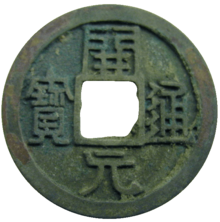| Value | 1 wén |
|---|---|
| Composition | Bronze,[b] lead, "white bronze", iron,[c] silver, or gold[1] |
| Years of minting | 621–907 |
| Obverse | |
 | |
| Design | Kaiyuan Tongbao (開元通寳) |
| Designer | Ouyang Xun (歐陽詢)[2] |
| Reverse | |
| Design | Usually blank, sometimes with nail marks, crescents, dots, or clouds, while "Huichang Kaiyuan Tongbao" cash coins tend to have mint marks (see below). |
The Kaiyuan Tongbao (traditional Chinese: 開元通寶; simplified Chinese: 开元通宝; pinyin: kāiyuán tōng bǎo; lit. 'Circulating treasure from the inauguration of a new epoch'), sometimes romanised as Kai Yuan Tong Bao or using the archaic Wade-Giles spelling K'ai Yuan T'ung Pao,[3] was a Tang dynasty cash coin that was produced from 621 under the reign of Emperor Gaozu and remained in production for most of the Tang dynasty until 907.[4] The Kaiyuan Tongbao was notably the first cash coin to use the inscription tōng bǎo (通寶) and an era title as opposed to have an inscription based on the weight of the coin as was the case with Ban Liang, Wu Zhu and many other earlier types of Chinese cash coins.[5] The Kaiyuan Tongbao's calligraphy and inscription inspired subsequent Central Asian, Japanese, Korean, Ryūkyūan, and Vietnamese cash coins and became the standard until the last cash coin to use the inscription "通寶" was cast until the early 1940s in French Indochina.
The Kaiyuan Tongbao also signified a major change in how money circulated in the Chinese Empire, while previously cash coins were valued based on their weights, they would now be valued based on government regulations.
After the fall of the Tang dynasty Kaiyuan Tongbao coins would continue to be produced by various states of the Five Dynasties and Ten Kingdoms period.
During the Ming dynasty, and later dynasties, the Kaiyuan Tongbao would become the most important cash coin to be used in traditional Chinese medicine.[6][7]
Cite error: There are <ref group=lower-alpha> tags or {{efn}} templates on this page, but the references will not show without a {{reflist|group=lower-alpha}} template or {{notelist}} template (see the help page).
- ^ "Tang Dynasty 唐代 Gold Coin 金开元通宝". Marilyn Shea (University of Maine at Farmington). March 2010. Retrieved 9 June 2018.
- ^ Tang West Market Museum (2023). "Currency of Kaiyuan Period (one in gold, one in gilt bronze, one in silver)". United Nations Educational, Scientific and Cultural Organization (UNESCO). Retrieved 24 August 2023.
The characters on the coin were written by the famous calligrapher of early Tang Dynasty, OUYANG Xun,they translate to "circulated treasures at the beginning of the dynasty".
- ^ Sportstune.com K'ai Yuan coins by John Ferguson. Retrieved: 21 June 2018.
- ^ "Tang Dynasty (618-907) and the subsequent Ten States Five Kingdoms era (907-960 or so)". Luke Roberts at the Department of History - University of California at Santa Barbara. 24 October 2003. Retrieved 9 June 2018.
- ^ Hartill 2005, p. 103.
- ^ 古文錢,但得五百年之外者即可用,而唐高祖所鑄開元通寶,得輕重大小之中,尤為古今所重 (Ancient money can be used if it is more than five hundred years old, but the Kaiyuan Tongbao cast by Emperor Gaozu of the Tang Dynasty is especially important in ancient and current times.) - Compendium of Materia Medica(明·本草綱目)by Li Shizhen (李時珍).
- ^ 清朝的《本草拾遺》也提到“唐開元錢燒之有水銀出”。(in Classical Chinese).